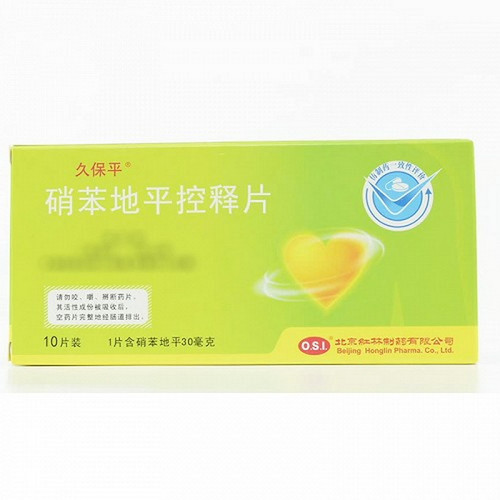Product Overview
[Drug Name]
Generic Name: Nifedipine Extended-Release Tablets (III)
Trade Name: Shengtongluo Nifedipine Extended-Release Tablets (III)
Chinese Pinyin: XiaoBenDiPingHuanShiPian (III)
[Ingredients]
Nifedipine
Chemical Name: 2,6-Dimethyl-4-(2-nitrophenyl)-1,4-dihydro-3,5-pyridinedicarboxylate
Molecular Formula: C17H18N2O6
Molecular Weight: 346.34
[Properties]
This product is a yellow tablet.
[Indications]
1. Hypertension; 2. Coronary heart disease, chronic stable angina (exertional angina).
[Dosage and Administration]
Oral: 30 mg once daily. This tablet should be swallowed whole and should not be chewed.
[Adverse Reactions]
1. Short-lived and most commonly seen are swelling of the ankles, feet, and calves, which can be relieved with diuretics. 2. Occasional chest pain, headache, flushing, dizziness, palpitations, and decreased blood pressure may occur. 3. Occasional abdominal pain, nausea, loss of appetite, and constipation may occur. 4. Gingival hypertrophy may occur.
[Contraindications]
1. This product is contraindicated in patients with known hypersensitivity to nifedipine or any of its ingredients. 2. Nifedipine is contraindicated in patients with cardiogenic shock. 3. Due to enzyme induction, effective plasma concentrations of nifedipine may not be achieved when used in combination with rifampicin. Therefore, it should not be used in combination with rifampicin. 4. Nifedipine is contraindicated in women who are pregnant for less than 20 weeks and are breastfeeding.
[Precautions]
1. For patients with heart failure and severe aortic stenosis, when blood pressure is very low (systolic pressure), please read the instructions carefully and use as directed by your doctor.
[Special Population Use]
Precautions for Children:
This product is contraindicated in children.
Precautions for Pregnancy and Lactation:
This product is contraindicated in pregnant women. Clinical studies on this product in nursing mothers are insufficient; it is recommended that patients not breastfeed.
Precautions for the Elderly:
This product may prolong its half-life, increase its Cmax and AUC, and should be taken at the lowest dose to reduce the incidence of adverse reactions.
[Drug Interactions]
1. This product is used in combination with nitrates to control angina attacks. 2. When taken with grapefruit juice, this drug increases its Cmax and AUC. 3. Concomitant use with digitalis may increase blood digoxin concentrations, suggesting that digoxin blood concentrations should be monitored during initial use, dose adjustments, or when discontinuing this drug. 4. Concomitant use with highly protein-bound drugs, such as dicoumarols, phenytoin, quinidine, quinine, and warfarin, often alters the free concentration of these drugs. 5. Concomitant use with cimetidine increases peak plasma concentrations, necessitating dose adjustments.
[Pharmacological Actions]
Dihydropyridine is a dihydropyridine calcium antagonist that selectively inhibits the entry of calcium ions into the transmembrane space of myocardial and smooth muscle cells. Transport and inhibit the release of calcium ions from intracellular stores without changing the plasma calcium ion concentration. Pharmacological action: This product can simultaneously dilate the coronary arteries in the normal blood supply area and the ischemic area, antagonize spontaneous or ergonovine-induced coronary artery spasm, increase the delivery of myocardial oxygen in patients with coronary artery spasm, and relieve and prevent coronary artery spasm. It can also inhibit myocardial contraction, reduce myocardial metabolism, and reduce myocardial oxygen consumption. On the other hand, it can dilate peripheral resistance vessels, reduce peripheral resistance, lower systolic and diastolic blood pressure, and reduce cardiac afterload. This product can delay the sinoatrial node function and atrioventricular conduction of the isolated heart; electrophysiological studies in whole animals and humans have not found that this product has a delaying effect. It has effects on atrioventricular conduction, prolongs sinus node recovery time, and slows sinus node regeneration. Toxicological effects: Carcinogenic, mutagenic, and reproductive toxicity. No carcinogenic effects. Non-mutagenic. High doses can reduce female rat fertility; may cause teratogenicity; and may induce abortion (increased fetal drug absorption, increased fetal mortality, and decreased neonatal survival). Administration of 2/3 to 2 times the maximum human dose to pregnant monkeys can result in small placentas and villous hypoplasia; administration of 3 times the maximum human dose to rats can cause prolonged gestation.
[Storage] Sealed.
[Specification] 30mg x 28s
[Expiry Date] 36 months
[Approval Number] National Medicine Standard H20133345







